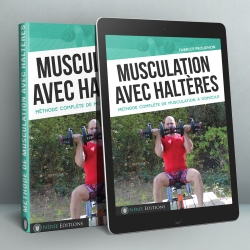These articles I wrote for the HR site.
s2.phpbbforfree.com/forum...yrese.html
And thought I'd post them here also for this board.
Training Frequency
Training frequency is a much debated and apparently, variable part of training. Multiple aspects of recovery and adaptation are blended together, such as rest, sleep, mental state, nutrition, age, and immune function. Prescribing a fixed and/or perfect frequency is thus very difficult. What is usually needed is a conditional prescription. i.e. If a person pays close attention to all controllable factors, rest, sleep, diet, etc. a general recommendation can be made.
Another point of consideration is optimal vs. workable. It's obvious that more equally productive sessions per time period will result in faster progress. Adjustments in the program may also be considered as a variable. A trainee may choose to alter the intensity and/or duration of training sessions while keeping a fixed frequency, or, they may adjust frequency while keeping a fixed intensity and/or duration. Both sides have 'logical' reasoning for each action. What is superior has not been proven.
What science has to say
Busso (1) compared training frequencies of 3d vs 5d per week. The conclusions were that 5d per week led to a higher level of fatigue and thus a longer recovery time. Obviously, the subjects were not recovering between sessions. If one is training in a 'single factor' model, the goal is to replicate a 'stimulation -> rest -> recover -> adapt' scenario before a subsequent stimulation is induced.
DeMichele (2) Tested rotational torso strength gains between 1d, 2d, and 3d per week subjects. No difference between 2d or 3d per week were found, but both 2d and 3d were superior to 1d per week.
Carroll (3) tested strength and MHC gains in the leg muscles for 2d vs. 3d per week training. In this study, results were similar but higher strength gains were seen in the 2d per week subjects. Other work (4) by some of the same researches earlier had shown that 3X week training for 12 weeks increased increased arm girth (5%) and forearm extensor strength (39%), associated with the triceps brachii muscle.
Significant changes in hypertrophy have been seen using various training frequencies. Abe (6) used a 3X weekly protocol, Staron (5,7) used 2X weekly both training programs produced significant increases in mass. Hakkinen (8) also used a 3X weekly approach but divided the daily volume into two daily sessions. No systematic changes took place in the cross-sectional area (CSA) of the quadriceps femoris muscle or in maximal voluntary isometric strength of the leg extensor muscles over training period I with one daily sessions. However, a significant (p < 0.05) enlargement in the cross-sectional area of the muscle occurred during period II. Both phases where 3 weeks in length and this could account for not seeing changes in the initial phase simply too short of a duration to see any change but we will discuss this in our “Duration” section.
Looking at exercise frequency in older adults, Taafe(9) shows that training more frequently than one time per week had little impact compared to higher frequencies (2 or 3 times per week). Using three sets of eight exercises targeting major muscle groups of the upper and lower body, at 80% of one-repetition maximum (1-RM) for eight repetitions, muscle strength and lean body mass increased in the exercise groups relative to control, with no difference among frequency groups at any measurement interval.
Too much, too little too late?
One last consideration is recognizing over training. There are two ways the term 'over training' appears to be used.
Training more often than optimal, with no ill effect
Training more often than optimal, with ill effects (over training syndrome)
The latter is usually seen in high caliber athletes, and over a longer period of training time. The common ground being, the former will or could lead to the latter. Many researchers are looking at the over training syndrome and some new light is being shed on it. Smith (10) puts forth a hypothesis that over training compromises immune function, leading to a signaling of the CNS. This signaling generally leaves one feeling lack luster, depressed, or other feelings of malaise.
The 'take home' message
If one is willing, and/or able, to adjust the factors needed for proper recovery, and are a healthy adult, twice weekly training per muscle or muscle group appears to be the optimal prescription. Superior results have not been found for higher frequencies of stimulation (in longer term situations), but lesser results have been found for lower frequencies.
A chain is only as strong as it's weakest link, and results are the final proof of a program. Intelligent trainees will note progress, and adjust factors such as sleep, nutrition, and the like, so that recovery and adaptation may take place at the fastest pace. If a factor is unalterable, and progress cannot be made with an optimal frequency, the trainee must then, decide to either adjust the amount of work or the training frequency (11-13).
____(1.)Busso, T. Effects of training frequency on the dynamics of performance response to a single training bout. J Appl Physiol. 2002 Feb;92(2):572-80.
(2.)DeMichele, PL.Isometric torso rotation strength: effect of training frequency on its development.Arch Phys Med Rehabil. 1997 Jan;78(1):64-9.
(3.)Carroll, TJ. Resistance training frequency: strength and myosin heavy chain responses to two and three bouts per week.Eur J Appl Physiol Occup Physiol. 1998 Aug;78(3):270-5.
(4.)Jurimae, J. Changes in the myosin heavy chain isoform profile of the triceps brachii muscle following 12 weeks of resistance training.Eur J Appl Physiol Occup Physiol. 1996;74(3):287-92.
(5.)STARON, R. S., Skeletalmuscle adaptations during early phase of heavy-resistance training in men and women. J. Appl. Physiol. 76:1247–1255, 1994.
(6.) ABE, T. Whole body muscle hypertrophy from resistance training: distribution and total mass Br J Sports Med 2003;37:543-545
(7.)STARON, R. S. Muscle hypertrophy and fast fiber type conversions in heavy resistance-trained women. Eur.J. Appl. Physiol. 60:71–79, 1989.
(8.)HAKKINEN, K. Distribution of strength training volume into one or two daily sessions and neuromuscular adaptations in female athletes. Electromyogr. Clin. Neurophysiol.34:117–124, 1994.
(9.)Taafe, D. Once-weekly resistance exercise improves muscle strength and neuromuscular performance in older adults.J Am Geriatr Soc. 1999 Oct;47(10):1208-14.
(10.)SMITH, L. L. Cytokine hypothesis of overtraining: a physiological adaptation to excessive stress? Med. Sci. Sports Exerc., Vol. 32, No. 2, pp. 317-331, 2000
(11.)Cronin, J. Training volume and strength and power development. J Sci Med Sport. 2004 Jun;7(2):144-55.
(12.) American College of Sports Medicine position stand. Progression models in resistance training for healthy adults. Med Sci Sports Exerc. 2002 Feb;34(2):364-80. Review.
(13.)Halson, SL. Does overtraining exist? An analysis of overreaching and overtraining research. Sports Med. 2004;34(14):967-81. Review.
_______________________________________________
Energetics
Introduction
There are several paths that lead to upregulated protein synthesis in resistance training. It would be naive to focus completely on any one, or to neglect the aspects of any one of the various signaling factors. Many times, a means is thought of as the actual stimulation. Or more simply, a method of applying a stimulation is deemed as an actual path of stimulation. An important marker for the hypertrophic stimulus, lies in the energetic cost of the set, usually in reference to the time span per amount of energy consumed. This is the energetic theory.
Definition
The energetic theory is one in which the energetic cost of the contractions, or sum of contractions, is used as a measurement tool for the upregulation of protein synthesis.(14) Many debate this, usually from a lack of understanding. An opposing point might be, that running or aerobics burn ample energy but are not a good stimulus for hypertrophy. This is true, but is wrongly applied to this theory. The energetic cost is more related to the time factor.(5,9,14,21) ie ATP turnover per time period. A muscle fiber uses ATP to break the contraction bonds, and burns it in proportion to the rate at which the sarcomeres are crossbridging.(5) This rate is determined by the neurological input frequency. (rate coding) Exercise which is of low intensity, calls for slower contractions of the motor unit pools. Thus, total energy for the exercise session might be high, but the rate at which ATP is turned over, is low.
The science of the energetic theory is based upon the action of mTOR (mammalian target of rapamycin). mTOR is a regulator of protein synthesis in a muscle cell, simply, it monitors and adjusts protein metabolism (synthesis/degradation) in response to energy requirements. mTOR is very sensitive to amino acids and insulin. How the process appears to work, is AMP-activated protein kinase (AMPK) blunts mTOR during contraction. By mTOR slowing protein synthesis, more ATP is available for use during the contractions. When contractions cease, mTOR rebounds to a higher level, increasing protein synthesis to a greater than resting levels. The presences of amino acids at this time also seem to be required. It's possible that a high ATP turnover, such as found during heavy or high intensity contractions, blunts mTOR to a maximum or close to maximum level, causing the highest level of rebound afterwards. The rebound level may or may not be proportion, or somehow related to the rate of ATP turnover and/or the time it is blunted. (5,14)
Explanations
The reason aerobics or endurance activities do not cause this effect, is due to the lower levels of tension. High rates of ATP turnover require high frequency contractions (rate coding).(9) The way in which the CNS manipulates activity is by the level of required effort. First order is to increase recruitment levels, once recruitment becomes full, then, and only then, will firing frequencies be increased. Depending in the muscle or muscle group in question, full recruitment will occur anywhere from approximately 40% (for smaller muscles such as those of the hand) to possibly 95% (upper thigh musculature) of maximum momentary MVC. Other muscles of the torso usually fall somewhere inbetween, such as biceps at approx. 70-80% of momentary maximum MVC. (16,17,18,22)
Note: The reason "momentary" maximum MVC is stressed, is to emphasize that the resistance does not have to be that particular percentage of fresh maximum force (percent of 1RM), but that anytime that level of effort is required, recruitment follows these patterns. For example, if your biceps reach full recruitment at 80% of 1RM, and your 1RM is 100lbs, a single rep with 80 pounds will induce full recruitment, as will the last several reps of a set with your 10RM, where fatigue has limited your strength. Anytime your CNS is putting out a "greater than the minimum" level of effort for full recruitment, rate coding is employed afterwards for further force requirements.
Cautions
A first thought is usually, "Why not just train to failure?". As far as energetics are concerned, yes, going to failure, and even beyond would cause a high sustained ATP turnover. However, there is a price to pay. Both short term, and long term. For short term, failure training and sustained high frequency type contractions may cause failure in the EC (excitation contraction) systems. Failure may lie in the local propagation of the neural signals.(23) And, it may cause a lengthy recovery period.(24) What this means, is your muscles may be long recovered and ready to go before your local neural system is up to performing those types of contractions with any meaningful intensity again. For long term, the mental toll of such taxing training can cause an overtraining of the CNS and systemic factors. Symptoms such as those found with depression may become evident. Loss of appetite, loss of desire, etc. Annecdotally, many find that with regular high effort training, long recovery periods are required before strength returns or even the desire to put oneself through another torturous affair of the like. Many trainees turn to stimulants, such as amphetimines or high doses of caffine to reach the needed level of mental effort for a productive session. These drugs work by increasing neuro-transmitters, ie. they 'wire up' the CNS. This itself, is evidence the CNS is the lacking component in continous training of this sort. (11,12)
A Better Application
Multiple sets are a safer and less taxing method for the neural systems. It is true there are many studies showing that single sets can be as effective for short term gains, but again, this involves the trainee making sure that the single set used, is maximized. A turn around could be said that all the studies show mutliple sets are as effective, or more effective than single sets.(1) A good way to think of this, is why kill yourself with one "do or die, all out, torturous" set, when a few, or at most, several more enjoyable sets could be performed? Anyone who has done both will know that the time factor is not of that much concern. After a killer single set, most end up on the floor "seeing stars" for several minutes before the next exercise can be performed. Instead, several 'less intense' sets could have also been performed in that time. And, with much less discomfort or ill effects.
We are not saying people should avoid training hard, and avoid pushing themselves. Progress is not easy and you will hit failure by accident now and again if your working hard. But, to work yourself to this point regularly, may not be the quickest means of progress.(11,12,24)
Assurance
How do we know that energetics are even a viable marker? First, studies using occlusion have found rapid increases in size and strength, with very low resistance.(6,7) The fatigue induced from the lack of blood flow, causes the muscles to reach full recruitment and high levels of rate coding with very low whole muscle tension. Damage, or micro-trauma is low to non-existant but marked hypertrophy is still evident. Further, what was once thought to be damage, is now seen to be more of the remodeling process.(13) The smeared Z lines found in exercised muscle cells, are much more evident several days after exercise. If damage from the contractions were causing this, they would be seen immediately. Since their prominence is greater days afterwards, it shows the process of recovery has caused this rather than the acute effects of exercise. Why is this important? This effect (smeared Z lines) is sometimes, but not always, in accordance with DOMS. One of the best explanations of DOMS, describes the effects stemming from high intra-cellular calcium concentrations initiating the process, and the time course of the immune system following the time course of the soreness.(15) High peak tension, eccentrics, and many other aspects of training, including high frequency contractions, can increase intra-cellular calcium concentrations through various means.(3) We've all experienced increased levels of DOMS with higher levels of intensity and/or the volume of exercise. Obviously, both of these applications (intensity and volume) are increasing the stimulation of the remodeling process.
Also, a measurement variable, termed TTI (Tension Time Integral), where the average true tension is computated, (4,5) is directly proportional to the energetic cost of a contraction. Even tension signaling factors, such as P70 (70-kDa ribosomal S6 kinase, an important marker for hypertrophy) (9,10) can be tracked by calculating the TTI of the contractions. One can then extrapolate, that ATP turnover (the energetic cost/time) is proportional to the stimulation induced by resistance based contractions. (5,6,7,8,21)
Means To an End
What your seeking, is protein upregulation. Your means is through an application of external resistance that will induce full recruitment and higher levels of rate coding.
Application
Keeping with a CNS and EC friendly method, a repeated application is probably superior to a single all out set. (as discussed above)
*Multiple hard, but not to failure, sets
*Density type programs. Work per time unit is a watched variable
*Heavy/Light setups. Work is equalized while the load is alternated
*Rapid progression programs. Work is equalized while load is increased
(1,2,3,19,20)
References
1) Human Skeletal Muscle Hypertrophy Jose Antonio, Ph.D.
2) Carey-Smith R, Rutherford OM: The role of metabolites in strength training. Eur J Appl Physiology
3) Calcineurin Is Required for Skeletal Muscle Hypertrophy* Shannon E. Dunn, Jennifer L. Burns, and Robin N. Michel 1999
4) Influence of tension time on muscle fiber sarcolemmal injury in rat diaphragm
Ercheng Zhu, Alain S. Comtois, Liwei Fang, Norman R. Comtois, and Alejandro E. Grassino
5) Tension-time index, fatigue, and energetics in isolated rat diaphragm: a new experimental model Paul F. Klawitter1 and Thomas L. Clanton2 2003
6) Skeletal muscle size and circulating IGF-1 are increased
after two weeks of twice daily “KAATSU” resistance
training T. Abe, T. Yasuda, T. Midorikawa, Y. Sato, C. F. Kearns, K. Inoue, K. Koizumi, N. Ishii 2005
7) Effects of resistance exercise combined with moderate vascular occlusion on muscular function in humans. Takarada Y, Takazawa H, Sato Y, Takebayashi S, Tanaka Y, Ishii N.
8) CONTROL OF THE SIZE OF THE HUMAN MUSCLE MASS Michael J. Rennie,1,4 Henning Wackerhage,1 Espen E. Spangenburg,3 and Frank W. Booth 2 2004
9) Intracellular signaling specificity in skeletal muscle in response to different modes of exercise Gustavo A. Nader and Karyn A. Esser 2001
10) Phosphorylation of p70S6k correlates with increased skeletal muscle mass following resistance exercise Keith Baar1,2 and Karyn Esser2 1999
11) Resistance exercise overtraining and overreaching. Neuroendocrine responses.
12) Spinal and Supraspinal Factors in Human Muscle Fatigue
S. C. Gandevia Prince of Wales Medical Research Institute, Prince of Wales Hospital and University of New South Wales, Sydney, Australia
13) Evidence for myofibril remodeling as opposed to myofibril damage in human muscles with DOMS: an ultrastructural and immunoelectron microscopic study. Yu JG, Carlsson L, Thornell LE.
14) Regulation of mTOR by amino acids and resistance exercise in skeletal muscle. Deldicque L, Theisen D, Francaux M.
15) Enoka; Neuromechanics of Human Movement 3rd edition (Clarkson, Cyrnes, McCarmick, Turcotte, & White, 1986; Friden & Lieber, 1997' Jackson, Jones, & Edwards, 1984; Armstrong, 1990; Lieber, Schimtz, et al., 1994; Malm, Lenkel, & Sjodin, 1999)
16) Enoka; Neuromechanics of Human Movement 3rd edition (Deluca, LeFever, McCue & Xenakis, 1982a; Kukulka & Clamann, 1981; Van Cutsem et al,. 1997)
17) Intermuscle differences in activation. Behm DG, Whittle J, Button D, Power K.
18) Influence of exercise and training on motor unit activation. Sale DG.
19) Effects of low-intensity resistance exercise with short interset rest period on muscular function in middle-aged women. Takarada Y, Ishii N.
20) Fatigue contributes to the strength training stimulus. Rooney KJ, Herbert RD, Balnave RJ.
21) Mechanism of work-induced hypertrophy of skeletal muscle. Goldberg AL, Etlinger JD, Goldspink DF, Jablecki C.
22) Motor unit activity during long-lasting intermittent muscle contractions in humans. Christova P, Kossev A.
23) Behavior of motor units in human biceps brachii during a submaximal fatiguing contraction. Garland SJ, Enoka RM, Serrano LP, Robinson GA.
24) Neuromuscular disturbance outlasts other symptoms of exercise-induced muscle damage.Deschenes MR, Brewer RE, Bush JA, McCoy RW, Volek JS, Kraemer WJ.
_______________________________________________
Occlusion: What's blood got to do with it?
Ron Sowers
It may not be a Tina Turner song, but it's a question were going to look at in this article.
A lot of this discussion is really a deeper look at the energetic theory, specifically, how blood flow affects fatigue, and then how fatigue affects recruitment and contraction.
In several occlusion studes, where mechanical pressure was used to restrict blood flow, subjects were able to increase strength and muscle size with lighter weights as well as non-resistricted subjects, who used higher resistances. (1,2) One particular study (1) observed a 7.7% increase in the quadriceps CSA within two weeks using a mere 20% of 1RM! Fibril size, glycogen, GH and IGF1 are also significantly increased during training with occluded blood flow. (1,7)
How can such a light weight actually stimulate strength and size increases? Where is the coveted mechancial tension? Could it be that the load on the bar is not 'the stimulus', but, is more of a means to an end?
The reason such light resistances still have the ability to stimulate size and strength increases, is thought to be from the following reasons; The extremely high 'backing up' of fatigue products, in addition to a lack of oxygen, reduces the fiber's ability to generate force very rapidly.(3) This leads to full activation levels (full recruitment and high rate coding) leading to tetanic contractions. (2) Further, muscle cells will consume ATP at rates equal to higher resistances. The importance of this was spoke of in the energetics article. To borrow a section,
Quote:
"Also, a measurement variable, termed TTI (Tension Time Integral), where the average true tension is computated, (4,5) is directly proportional to the energetic cost of a contraction. Even tension signaling factors, such as P70 (70-kDa ribosomal S6 kinase, an important marker for hypertrophy) (9,10) can be tracked by calculating the TTI of the contractions. One can then extrapolate, that ATP turnover (the energetic cost/time) is proportional to the stimulation induced by resistance based contractions. (5,6,7,8,21)"
Interestingly, the actual level of ATP can be lower in ischemic conditions (3), possibly leading to a significant repression of mTOR. However, the slower twich fibers, being more dependant on oxygen, may be affected to a greater extent. (4,9)
In normal anisometric contractions, blood flow can be limited or even occluded at higher contraction tensions, and/or frequencies, if the whole muscle tension is high enough. (5) Isometric contractions can have the most profound effect due to the absence of lower tension periods. Higher force and increased frequencies do stimulate a need for increased blood flow, and until muscle pressure limits this, it does indeed increase. (5,6) Both peak tension and work performed are indicators of this. (6)
Besides external pressure,(as with a cuff) internal muscle pressure can, and does occlude blood flow. With standard anisometric contractions variations in tension throughout the range of motion cause these effects to be intermitant. However, with isometric contractions, tension is maintained and non-variable, allowing a longer time period of impeded blood flow. Studies have tested various muscles with isometric contractions to find a minimum tension level where blood flow is occluded. Here are is some of the data,
Biceps, quadriceps and calves fell between 50 and 64% MVC (10)
Triceps 25%, biceps 50%, and back extensors 40% MVC (11)
There are two main points we can learn and/or use from this information;
1) High fiber activity levels, reguardless of the load, still induce myofibrilliar hypertrophy. Tension is a means to an end. The stimulus lies in the higher rates of work per time. This explains why better results are seen with repeated efforts. The first rep of a set using a 5RM, has the same peak tension as the last, but performing all 5 is more stimulating than performing just the one.
2) A person can take advantage of the effects of occlusion without tying tubes and bands around their limbs. (Please, avoid using occlusion to train your neck muscles) Furthermore, one would not have to use a pure isometric workout, but possibly use isometric contractions as 'finishers' or additions, to a normal set of repetitions.
1)T. Abe, T. Yasuda, T. Midorikawa, Y. Sato, C. F. Kearns, K. Inoue, K. Koizumi, N. Ishii 2005
2) Yudai Takarada, Haruo Takazawa, Yoshiaki Sato, Shigeo Takebayashi3, Yasuhiro Tanaka, and Naokata Ishii 2000
3) Michael C. Hogan1, L. Bruce Gladden2, Bruno Grassi3, Creed M. Stary1, and Michele Samaja4 1998
4) B. G. Mackie and R. L. Terjung
5) Brian D. Hoelting, Barry W. Scheuermann, and Thomas J. Barstow
6) Jason J. Hamann,1 John B. Buckwalter,1 Philip S. Clifford,1 and J. Kevin Shoemaker2
7) BURGOMASTER, KIRSTEN A.; MOORE, DAN R.; SCHOFIELD, LEE M.; PHILLIPS, STUART M.; SALE, DIGBY G.; GIBALA, MARTIN J. 2003
8) Yudai Takarada1, Yutaka Nakamura2, Seiji Aruga2, Tetuya Onda2, Seiji Miyazaki2, and Naokata Ishii3 2000
9) J. S. Petrofsky, C. A. Phillips, M. N. Sawka, D. Hanpeter and D. Stafford 1981
10) Sadamoto T, Bonde-Petersen F, Suzuki Y. 1983
11) F. Bonde-Petersen, A. L. Mørk1 and E. Nielsen 1974Occlusion: What's blood got to do with it?
Articles de Ron Sowers
18 messages
• Page 1 sur 1
Articles de Ron Sowers
Très technique, mais ca peut en intéresser 2 ou 3. Pour accéder à tous les articles et discussions je peux vous inviter sur le forum si jamais.
Gagner du muscle : Progressive Resistance
Perdre du gras : Input < Output
Strict Curl 1x58kg
Bakawa shinanakya naoranai
Les idiots ne guerrissent qu'en mourant.
Perdre du gras : Input < Output
Strict Curl 1x58kg
Bakawa shinanakya naoranai
Les idiots ne guerrissent qu'en mourant.
Articles de Ron Sowers
Ça chamboule un peu ma philosophie 
Au moins, ça approuve le fait qu'une bonne série à l'échec & beyond est efficace!
Au moins, ça approuve le fait qu'une bonne série à l'échec & beyond est efficace!
Faire du vélo pour les jambes c'est comme manger des protéines végétales pour renforcir le coeur de Gromit
Articles de Ron Sowers
Au moins, ça approuve le fait qu'une bonne série à l'échec & beyond est efficace!
Pas quand tu connais l'auteur des articles... 15 ans d'entrainement. 5*86 au DC, et physique lambda.
-

Fabrice SP - Administrateur
- Messages: 13796
- Inscription: 15/05/2003 19h42
- Réputation: 236
Articles de Ron Sowers
C'est pas bien bien grave: je le fais déjà son 5x86  Et ça devait faire 6 mois que je n'avais pas fait de DC sérieusement!
Et ça devait faire 6 mois que je n'avais pas fait de DC sérieusement! 

Faire du vélo pour les jambes c'est comme manger des protéines végétales pour renforcir le coeur de Gromit
Articles de Ron Sowers
what a fuck vince!! you think everybody off us speack english??
you lose!
you talking to me??!!
shit vince!! give us french articles!!!!
you lose!
you talking to me??!!
shit vince!! give us french articles!!!!

Articles de Ron Sowers
j'aimerais bien mais les francais soit ils publient pas sur le net, soit c'est des trucs dépassés de 10 ou 20 ans, donc 
C'est vraiment rare de trouver des études francaises, de temps en temps l'université de bordeau et/ou bologne est citée pour ses études...
C'est vraiment rare de trouver des études francaises, de temps en temps l'université de bordeau et/ou bologne est citée pour ses études...
Gagner du muscle : Progressive Resistance
Perdre du gras : Input < Output
Strict Curl 1x58kg
Bakawa shinanakya naoranai
Les idiots ne guerrissent qu'en mourant.
Perdre du gras : Input < Output
Strict Curl 1x58kg
Bakawa shinanakya naoranai
Les idiots ne guerrissent qu'en mourant.
Articles de Ron Sowers
Vincent a écrit:j'aimerais bien mais les francais soit ils publient pas sur le net, soit c'est des trucs dépassés de 10 ou 20 ans, donc
+1
Articles de Ron Sowers
On a tellement à apprendre que même avec 10 ans de retard, c'est pas bien grave pour commencer. 
Articles de Ron Sowers
mai sauf que tu risques d'apprendre des betises comme ta théorie du recrutement 
Gagner du muscle : Progressive Resistance
Perdre du gras : Input < Output
Strict Curl 1x58kg
Bakawa shinanakya naoranai
Les idiots ne guerrissent qu'en mourant.
Perdre du gras : Input < Output
Strict Curl 1x58kg
Bakawa shinanakya naoranai
Les idiots ne guerrissent qu'en mourant.
Articles de Ron Sowers
Apprend déja comment se contracte un muscle. On en reparlera après.
Je te conseille : Neurophysiologie de Didier Orsal !
Je te conseille : Neurophysiologie de Didier Orsal !
Articles de Ron Sowers
Kalu a écrit:what a fuck vince!! you think everybody off us speack english??
you lose!
you talking to me??!!
shit vince!! give us french articles!!!!
YOU TALKING TO ME?????????!!!!!!!!!!!
Articles de Ron Sowers
Vincent a écrit :
j'aimerais bien mais les francais soit ils publient pas sur le net, soit c'est des trucs dépassés de 10 ou 20 ans, donc
C'est vraiment rare de trouver des études francaises, de temps en temps l'université de bordeau et/ou bologne est citée pour ses études...
J'ai une idée pour régler se probleme, écrit ta propre article
Articles de Ron Sowers
Il ne sait meme pas comment se contracte un muscle. Alors pour écrire un article, c'est mal barré sauf si c'est pour raconter de la merde à des ignards !
Articles de Ron Sowers
pour écrire un article qui soit pas complètement inutile (recracher le fonctionnement de la contraction qu'on a lu dans un bouquin) ou faux (basée sur la "science actuelle"), il vaut mieux écrire quelque chose de basé sur la logique (en partant d'éléments scientifiques tenus pour certains donc relativement basiques) et plutot s'intéresser à la méthode qu'à la théorie !
Gagner du muscle : Progressive Resistance
Perdre du gras : Input < Output
Strict Curl 1x58kg
Bakawa shinanakya naoranai
Les idiots ne guerrissent qu'en mourant.
Perdre du gras : Input < Output
Strict Curl 1x58kg
Bakawa shinanakya naoranai
Les idiots ne guerrissent qu'en mourant.
18 messages
• Page 1 sur 1
Retourner vers Entraînement Musculation
-
- DISCUSSIONS EN RELATION
- Réponses
- Vus
- Dernier message
-
- Les gains musculaire les plus rapides de Sowers
par Vincent » 17/04/2006 01h48 - 10 Réponses
- 5383 Vus
- Dernier message par Alban

17/04/2006 19h33
- Les gains musculaire les plus rapides de Sowers
-
- Articles Monde du Muscle
par Logan » 11/07/2011 12h53 - 4 Réponses
- 1937 Vus
- Dernier message par BodyGilles

12/07/2011 10h37
- Articles Monde du Muscle
-
- Nouvelle méthode : Accelerated Inroad Training (Ron Sowers)
1, 2par Vincent » 19/12/2005 11h17 - 70 Réponses
- 10469 Vus
- Dernier message par Rudy

25/12/2005 23h48
- Nouvelle méthode : Accelerated Inroad Training (Ron Sowers)
-
- StrivePerformance.com : vidéos et articles sur les kettlebells !
par Fred » 09/06/2010 21h55 - 0 Réponses
- 1935 Vus
- Dernier message par Fred

09/06/2010 21h55
- StrivePerformance.com : vidéos et articles sur les kettlebells !
-
- Sommaire des articles de Laurent Buhler
par Laurent Buhler » 14/01/2012 15h35 - 0 Réponses
- 7967 Vus
- Dernier message par Laurent Buhler

14/01/2012 15h35
- Sommaire des articles de Laurent Buhler
-
- Site avec pleins d'articles sur le powerlifting
par Fabrice SP » 21/08/2003 10h34 - 22 Réponses
- 9575 Vus
- Dernier message par Seb33

25/08/2003 10h06
- Site avec pleins d'articles sur le powerlifting
Qui est en ligne
Utilisateurs parcourant ce forum: aucun utilisateur enregistré et 25 invités







